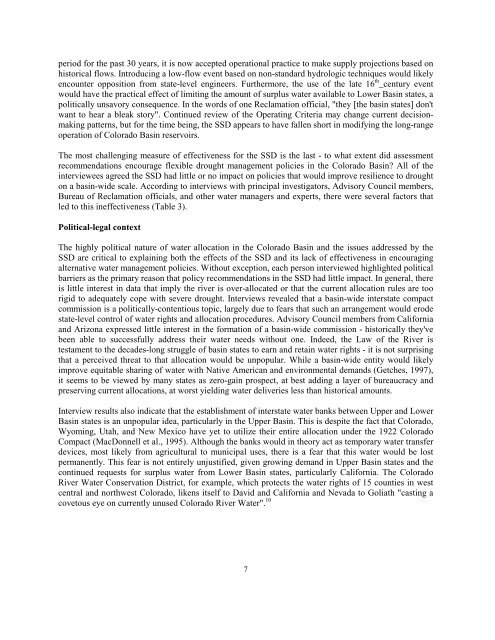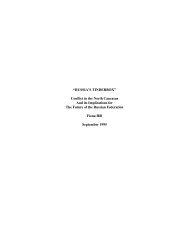Global Environmental Assessment Project - Belfer Center for ...
Global Environmental Assessment Project - Belfer Center for ...
Global Environmental Assessment Project - Belfer Center for ...
Create successful ePaper yourself
Turn your PDF publications into a flip-book with our unique Google optimized e-Paper software.
period <strong>for</strong> the past 30 years, it is now accepted operational practice to make supply projections based on<br />
historical flows. Introducing a low-flow event based on non-standard hydrologic techniques would likely<br />
encounter opposition from state-level engineers. Furthermore, the use of the late 16 th _century event<br />
would have the practical effect of limiting the amount of surplus water available to Lower Basin states, a<br />
politically unsavory consequence. In the words of one Reclamation official, "they [the basin states] don't<br />
want to hear a bleak story". Continued review of the Operating Criteria may change current decisionmaking<br />
patterns, but <strong>for</strong> the time being, the SSD appears to have fallen short in modifying the long-range<br />
operation of Colorado Basin reservoirs.<br />
The most challenging measure of effectiveness <strong>for</strong> the SSD is the last - to what extent did assessment<br />
recommendations encourage flexible drought management policies in the Colorado Basin? All of the<br />
interviewees agreed the SSD had little or no impact on policies that would improve resilience to drought<br />
on a basin-wide scale. According to interviews with principal investigators, Advisory Council members,<br />
Bureau of Reclamation officials, and other water managers and experts, there were several factors that<br />
led to this ineffectiveness (Table 3).<br />
Political-legal context<br />
The highly political nature of water allocation in the Colorado Basin and the issues addressed by the<br />
SSD are critical to explaining both the effects of the SSD and its lack of effectiveness in encouraging<br />
alternative water management policies. Without exception, each person interviewed highlighted political<br />
barriers as the primary reason that policy recommendations in the SSD had little impact. In general, there<br />
is little interest in data that imply the river is over-allocated or that the current allocation rules are too<br />
rigid to adequately cope with severe drought. Interviews revealed that a basin-wide interstate compact<br />
commission is a politically-contentious topic, largely due to fears that such an arrangement would erode<br />
state-level control of water rights and allocation procedures. Advisory Council members from Cali<strong>for</strong>nia<br />
and Arizona expressed little interest in the <strong>for</strong>mation of a basin-wide commission - historically they've<br />
been able to successfully address their water needs without one. Indeed, the Law of the River is<br />
testament to the decades-long struggle of basin states to earn and retain water rights - it is not surprising<br />
that a perceived threat to that allocation would be unpopular. While a basin-wide entity would likely<br />
improve equitable sharing of water with Native American and environmental demands (Getches, 1997),<br />
it seems to be viewed by many states as zero-gain prospect, at best adding a layer of bureaucracy and<br />
preserving current allocations, at worst yielding water deliveries less than historical amounts.<br />
Interview results also indicate that the establishment of interstate water banks between Upper and Lower<br />
Basin states is an unpopular idea, particularly in the Upper Basin. This is despite the fact that Colorado,<br />
Wyoming, Utah, and New Mexico have yet to utilize their entire allocation under the 1922 Colorado<br />
Compact (MacDonnell et al., 1995). Although the banks would in theory act as temporary water transfer<br />
devices, most likely from agricultural to municipal uses, there is a fear that this water would be lost<br />
permanently. This fear is not entirely unjustified, given growing demand in Upper Basin states and the<br />
continued requests <strong>for</strong> surplus water from Lower Basin states, particularly Cali<strong>for</strong>nia. The Colorado<br />
River Water Conservation District, <strong>for</strong> example, which protects the water rights of 15 counties in west<br />
central and northwest Colorado, likens itself to David and Cali<strong>for</strong>nia and Nevada to Goliath "casting a<br />
covetous eye on currently unused Colorado River Water". 10<br />
7
















